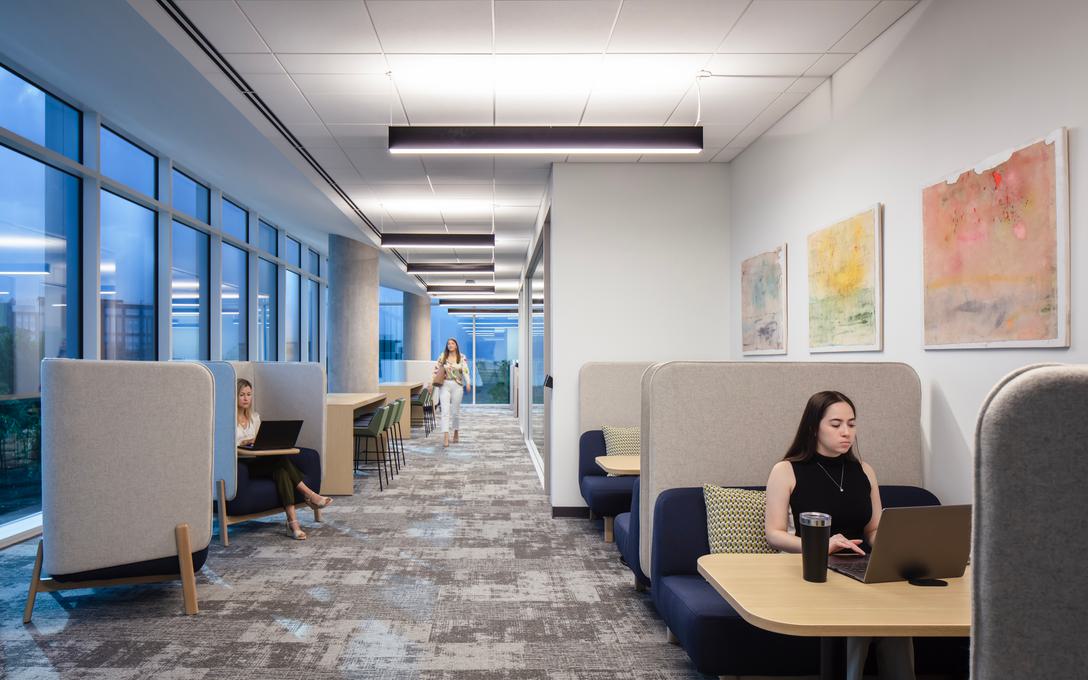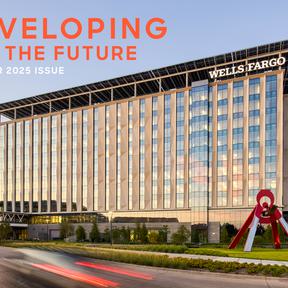
Office Space Definitions are Changing; Here’s What You Need to Know
03/08/23 | Thought Leadership

By Debra Velez, KDC Senior Vice President-Design & Construction
It’s the elephant in the room. You see it there, but no one really wants to acknowledge it. What is it, you ask? The “it” in this case applies to what today’s workforce wants and needs – yes, needs – to get back in the office. And it certainly has changed in the past three years.
When we're talking to our clients - who are very astute and knowledgeable - they want to see their workforce return to the office and simultaneously feel fulfilled. But that is coupled with a sense of apprehension about what it takes to attract and retain talent.
What’s changed?
Coming out of the pandemic, we have seen many workplace description meanings change. As these words are reinvented, corporate leaders want to know the latest intel on what they should be looking for and how to translate this data into a productive, happy workforce who wants to come to the office.
We look at corporate spaces differently today than we did just three years ago. These three hot topics dominate our conversations: amenities, mobile/flexible workspace, and workplace equity. Stay with me, and I’ll explain how these words have been redefined and why it’s something leadership should keep on their radar.
More Than a Fitness Center & a Deli
The concept of amenities has shifted with a move toward the unique. If you ask someone what an amenity is, you’ll likely get a thousand different responses. In the 1950s, it was an executive dining room then it coalesced into the deli and a fitness center.
Today, it has evolved into a broad spectrum of everything, such as a mini pop-up art museum showcasing the company’s brand or history. It could even be a location next to a public transit station or offering food and dining options in visionary ways from a cooking lesson during your lunch break or bringing food trucks to the office. It currently takes thoughtful reimagination.
In bigger cities like Dallas or Atlanta, we are seeing sculptures in lobbies featuring a new artist or the creation of a feeling invoked by the piece. In some cases, leadership may be pulling their own art pieces from treasured collections to share with their entire team. That’s the best part, they are amenities for all by allowing everybody to have that moment. I love that we're seeing amenities on the lobby level or outside. It is the insertion of those moments of time that you can experience as you navigate the building or its surroundings.
Amenities can evoke an emotional response everyone can appreciate. That has become more a part of the amenities vernacular as well. It's no longer food and wellness but an experience.
Don’t Call it Hybrid
Hybrid is a confusing word, often invoking negativity because of its use during and after the pandemic. Immediately, people think it means a combination of working from home and in the office. The problem with the term hybrid is a lot like saying amenities – there are too many definitions around it.
Let's just call it what it is: a mobile flexible workspace. Simply put, the workforce today is about mobility, and often that includes working partially remotely. So, let’s examine how to incorporate flexibility for the employee who is going to move about this space and how to handle them being partially remote.
What the industry did wrong starting in the 1960s thru the 90s was the creation of the cube farm. Companies equated promotions with space. So, if you worked in a cubicle with taller walls, it was a status symbol. Then, if you had an office, that was the next step up.
Google, Facebook, and the like broke barriers when they stopped equating success with the corner office. Today, the workforce is more attuned to an office where creativity can be spurred. This might be something as simple as having all pink pens and color-coordinated Post-it notes.
What’s more desirable today is a benching system, which is essentially a layout that uses long, shared worksurfaces to connect workstations. To the uninformed, it's simply a metal frame and table-based structure, which gives a lighter feel. The absence of panels and minimal separation means more open communication between staff and teams.
Before the pandemic, offices were denser, and now that we’re coming out of it, we've gotten past putting up plexiglass walls. We're literally and figuratively breaking barriers down and employers are taking time to think about how to foster employee growth and creativity.
The question is how to take a 45k SF floor plate and create a flexible space for them to work and be comfortable. Employees are our biggest asset, and we all want to attract the best and retain them in a place where they are proud to be. This is a great segue into the next catchphrase for today’s workplace.
Workplace Equity
The term workplace equity has changed over the past 10 years, and today most people recognize it as fair treatment, access, and advancement for each person in an organization. Here, we are talking about providing every employee with the sense of feeling heard and seen, as well as what they need to be creative and successful in the workplace.
That may mean having a flexible workplace and work hours. It is also bringing in the things you need to do your particular job well. You have your heads-down areas, closed conference rooms here and there, and opportunities for more casual collisions where employees who are walking to and from amenities see colleagues, spurring collaborative moments. So, we want to find a floorplate that fosters and really applauds those moments.
Technology also plays a role in equity. That can be in providing tech-centric wireless spaces throughout the office, providing technology for the workforce on the go and it can even mean providing headphones or earbuds.
We are seeing fit-outs focused on technology and the infrastructure needed to support the ever-evolving technology that's coming at us at a lightning speed. So, if you're going to create a tech-centric flexible workspace, it means I can now take my laptop and my phone and if I don't want to work in my designated space, I can go work in flex Space B tomorrow on another floor because all I need is my phone and my laptop to connect. It's wireless, it's Bluetooth. This is called a hot seat or choice seating or open address – there are many names for this.
Forget the Cookie Cutters
If a company’s leadership wants to create a workplace where their employees feel fostered and cared for in a building they are proud to come to work in, this is where KDC thrives. Examining their mission and goals, we can take these new buzzword definitions and find a solution.
The trick is to toss out the cookie cutters; it is all about customization these days. Companies that bring their mission to the forefront and look at the office in a different light can find the success they want. And, maybe on their way to get a drink from the break room, they can encounter a teammate and have a great jam session about their latest project.




